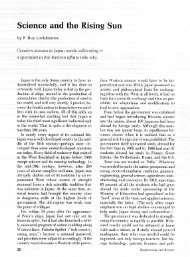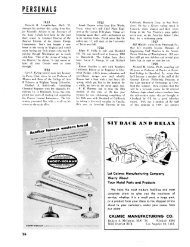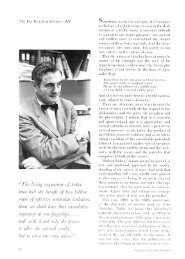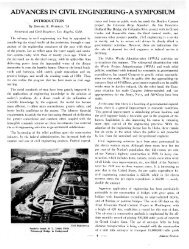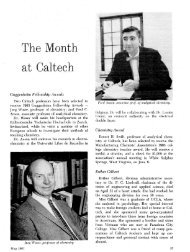indicates - Engineering & Science - California Institute of Technology
indicates - Engineering & Science - California Institute of Technology
indicates - Engineering & Science - California Institute of Technology
You also want an ePaper? Increase the reach of your titles
YUMPU automatically turns print PDFs into web optimized ePapers that Google loves.
We adapted this article<br />
from a Watson Lecture<br />
given in January.<br />
Philosophical Magazine Series 3 (1839) 14, p. 127.<br />
www.tandf.co.uk<br />
Above: Sir William Grove’s<br />
1839 gas battery, the first<br />
fuel cell, contrasts with<br />
Sossina Haile’s miniature<br />
solid-acid fuel cell, aka<br />
“Oreo cookie,” opposite.<br />
“A simple chemical reaction between hydrogen and oxygen generates energy,<br />
which can be used to power a car producing only water, not exhaust fumes.<br />
With a new national commitment, our scientists and engineers will overcome<br />
obstacles to taking these cars from laboratory to showroom so that the first car<br />
driven by a child born today could be powered by hydrogen, and pollutionfree.<br />
Join me in this important innovation to make our air significantly<br />
cleaner, and our country much less dependent on foreign sources <strong>of</strong> energy.”<br />
President George W. Bush, State <strong>of</strong> the Union Address, January 2003.<br />
Fuel cells are taking the country by storm. Even<br />
the president <strong>of</strong> the United States is talking about<br />
them. While automobile makers compete to make<br />
the first mass-market cars running on hydrogen<br />
or methanol, fuel-cell-driven power plants have<br />
already been installed in commercial buildings,<br />
hospitals, and homes. And research departments—<br />
mine included—are developing miniature versions<br />
that can fit in your pocket and be refueled with<br />
a shot <strong>of</strong> methanol or lighter fluid. Invented in<br />
1839 by Sir William Grove, a Welsh lawyer and<br />
amateur physicist, fuel cells were more or less forgotten<br />
until NASA developed them for the space<br />
program in the 1960s. Why so much interest now?<br />
World energy consumption is rising dramatically,<br />
and most <strong>of</strong> this energy is generated by the<br />
combustion <strong>of</strong> fossil fuels. Although there are<br />
enough reserves <strong>of</strong> oil, gas, and coal to last well<br />
into the next century, there’s a lot <strong>of</strong> geopolitical<br />
uncertainty surrounding their supply (a major<br />
issue at the moment), and they’re causing an<br />
environmental catastrophe. The global increase<br />
in atmospheric carbon dioxide levels is truly very<br />
worrying. These levels were stable until the<br />
industrial revolution in the early 1800s, then<br />
began to rise rapidly. It’s quite clear that there’s<br />
an anthropogenic reason for this, in part because<br />
<strong>of</strong> our fossil-fuel consumption, but also in part<br />
because <strong>of</strong> the way we’ve consumed the forests<br />
that would otherwise have absorbed the carbon<br />
dioxide. The consequence in terms <strong>of</strong> global<br />
warming is that there’s been a small but significant<br />
increase in atmospheric temperatures since<br />
1880. What impact will this have? People are<br />
still debating that question, but do we want to<br />
do this experiment? I’m fairly certain I don’t.<br />
Oil consumption per capita in the industrialized<br />
world is four times the global average, so it’s<br />
really incumbent on us in the developed world<br />
to help solve this problem.<br />
Are fuel cells a possible solution? They’re<br />
certainly very attractive, because they are much<br />
“The Stone Age didn’t end because we ran out <strong>of</strong> stones.” Anon.<br />
2003<br />
more efficient than combustion engines. Even<br />
if they run on fossil fuels, the amount <strong>of</strong> carbon<br />
dioxide produced per action taken (such as per mile<br />
traveled or per unit <strong>of</strong> electricity generated) is much<br />
smaller. Fuel-cell efficiencies can be as high as 60<br />
percent, even 80–90 percent if combined with<br />
hot-water cogeneration, while combustion engines<br />
have much lower efficiencies, on the order <strong>of</strong> 10–<br />
30 percent. And fuel-cell efficiency is entirely<br />
independent <strong>of</strong> size, unlike combustion engines,<br />
which become more efficient the larger they get.<br />
So fuel cells are suitable for all sorts <strong>of</strong> applications,<br />
ranging from big stationary power plants to portable<br />
electronics. In terms <strong>of</strong> the environment, not only<br />
are carbon-dioxide emissions lower, but chemical<br />
reactions are very carefully controlled so that<br />
there are zero toxic emissions. Best <strong>of</strong> all, fuel<br />
cells are very well-suited to a hydrogen economy.<br />
Run on hydrogen, they are a truly zero-emission<br />
energy device.<br />
How do they work? Hydrogen and oxygen put<br />
together will inherently react to form water, with<br />
the release <strong>of</strong> a lot <strong>of</strong> energy:<br />
H + 2 1 / O → H O + energy.<br />
2 2 2<br />
In the simple fuel cell shown on the following page,<br />
in which the fuel is hydrogen and the oxidant is<br />
oxygen, these two very reactive molecules are kept<br />
apart by an electrolyte, a material that lets only<br />
ions move through it. For the hydrogen to get<br />
to the oxygen, it has to turn into hydrogen ions,<br />
called protons (H + ). It does this by the reaction,<br />
H 2 → 2H + + 2e − ,<br />
to give us two protons and two electrons. The<br />
protons travel through the electrolyte and react with<br />
the oxygen on the other side. There they pick up<br />
two electrons and give water as a by-product:<br />
1 /2 O 2 + 2H + + 2e − → H 2 O.<br />
Electrons are produced on the hydrogen side (called<br />
the anode side, as in a battery) and consumed on<br />
ENGINEERING & SCIENCE NO. 1<br />
19



